4 Benefits of Proper Roof Installation
Your roof is your home’s first line of defense against wind, rain, hail, and heat. It’s regularly exposed to weather hazards and other harsh elements...
If you're in the process of planning a roof replacement, understanding the scheduling dynamics can be quite valuable. Typically, roofing projects are scheduled a few weeks ahead of time, allowing for adequate preparation before local weather predictions become available.
The challenge with weather lies in its unpredictability. Despite forecasts indicating rain for a specific time, the weather can swiftly change its course. This unpredictability occasionally leads to project delays or even interruptions if unexpected rain occurs.
Now, the question remains: What steps are taken if rain does indeed interrupt your ongoing roofing project?
In this blog, we’ll break down:
Let’s get started!
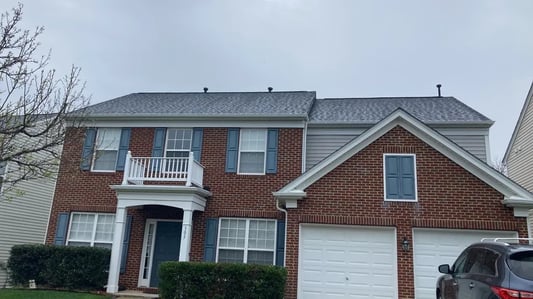
Opting to plan your roof replacement around potential rain is indeed a prudent approach. While waiting for optimal weather might seem inconvenient, especially during seasons when conditions are less favorable, it's essential to recognize the value of ensuring the project's proper execution instead of rushing through it.
Typically, residential roof replacements can be completed within a span of one to two days. To accommodate this timeframe, it's advisable to schedule the work during a period of anticipated sunshine, with a buffer of an extra day added at the end. This not only provides the necessary time for the roofing project but also allows you to fully appreciate and enjoy the outcome—a brand new roof that enhances the aesthetics and integrity of your home.
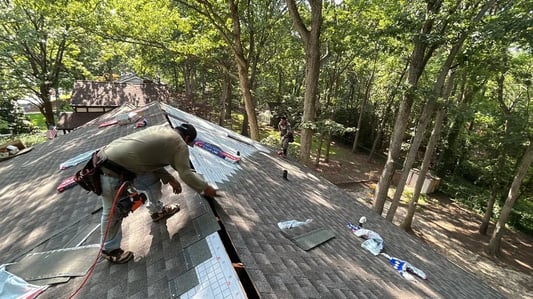
The duration of a typical roof replacement can vary based on factors such as the size of the home and prevailing weather conditions. For a standard-sized home, the process generally spans the entire day. However, the timeline can shift depending on specific circumstances. Smaller residences might witness completion by the mid-afternoon, while larger homes could necessitate two to three days for the project's finalization. Of course, the impact of weather and other relevant aspects can play a role in these timelines, which we'll delve into shortly.
We recommend that homeowners allocate one to two days in their schedules that might be influenced by the replacement process. This preparation accounts for potential adjustments to daily routines. Roofing crews and materials typically arrive at the job site as early as 6:30 or 7:00 AM. Starting early helps them avoid the labor-intensive aspects during the hottest part of the day. To facilitate the smooth execution of the project, we advise homeowners to ensure their vehicles and any necessary items are positioned outside of the driveway and garage. This proactive step prevents any potential inconvenience when the dumpster and materials arrive for the replacement.
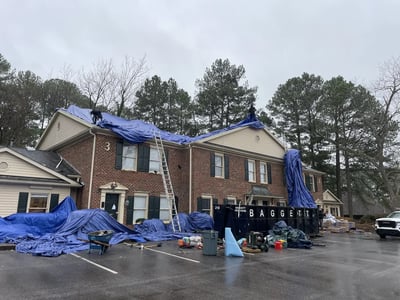
In the event of an unexpected rain shower while the project is underway, the roofing team will need to respond swiftly. The course of action depends on the rain's intensity and the specific phase of the roof replacement process.
Should the rain be moderate to heavy and construction is in progress, the roofers will likely pause their work, secure vulnerable areas, and await improved weather conditions. On the other hand, if the rain is relatively light and the underlayment has already been installed, the project might be able to proceed. The critical concern revolves around shielding the roof decking from exposure to water, as we will delve into further in the upcoming section. With the underlayment safeguarding this crucial layer and the rain resembling more of a mist, it could be feasible to continue installing the roofing material without compromising the quality of the work.
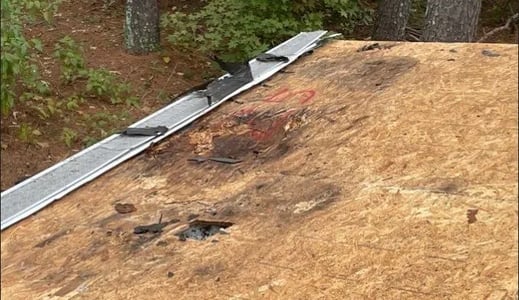
As previously highlighted, the most crucial layer of your roof to shield from the elements is the roof decking. This component constitutes a layer of wooden boards that secure your roofing material to your home's framework. In the unfortunate event of exposure to rain, these wooden boards can become saturated with water, leading to the onset of rot.
Should excessive water exposure occur, the affected sections of the roof decking would require replacement with new boards prior to the installation of fresh roofing material. Neglecting this step could result in significant weakening of your roof's structural integrity and overall framework due to the impairment caused by water damage. Ensuring the protection of your roof decking is an essential aspect of preserving your roof's longevity and performance.
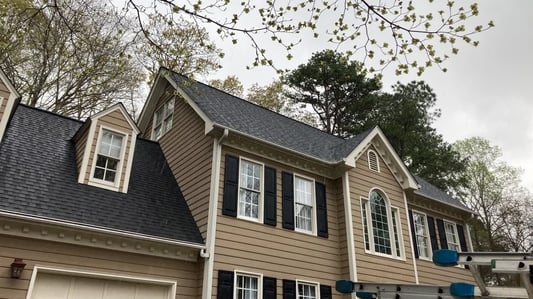
Unsurprisingly, weather wields significant influence over the timing and pace of a roof replacement project. Raleigh experiences a diverse range of weather conditions contingent on the season, and these factors can considerably impact the scheduling and progression of roofing projects.
Weather-related challenges extend beyond mere precipitation. Temperature fluctuations are equally consequential. Cold weather can render shingles more fragile, while hot weather might pose a risk of scarring and damage if shingles are inadvertently scuffed during installation. Consequently, the conditions necessitate a delicate balance between efficiency and precision to ensure the integrity of the roof replacement.
While weather is a perennial consideration, specific times of the year tend to be more conducive to roofing projects due to their more predictable conditions. In North Carolina, for instance, the summer months generally offer a higher likelihood of favorable weather for roof replacements. However, it's worth noting that the summer is typically a bustling time for roofing companies, making it important to secure a spot on their schedules well in advance.
Conversely, winter can present challenges due to potential delays caused by inclement weather, as asphalt shingles can't be installed in near-freezing temperatures. Additionally, shorter daylight hours during winter can impact the project's completion time, prompting many roofers to favor the extended daylight of the summer months.
Spring and fall, despite their reputation for milder weather, fall into the transitional period category. While these seasons can be suitable for roofing projects, they are not without their challenges. In Raleigh, spring often brings sporadic rainstorms that might disrupt ongoing work before completion. Thus, understanding the nuances of each season's weather patterns is essential for strategically planning a successful roof replacement project.
On Tops Roofing has been planning roofing projects since 1991, and has installed more than 10,000 roofs. Whatever your roof requires, We’re on it!
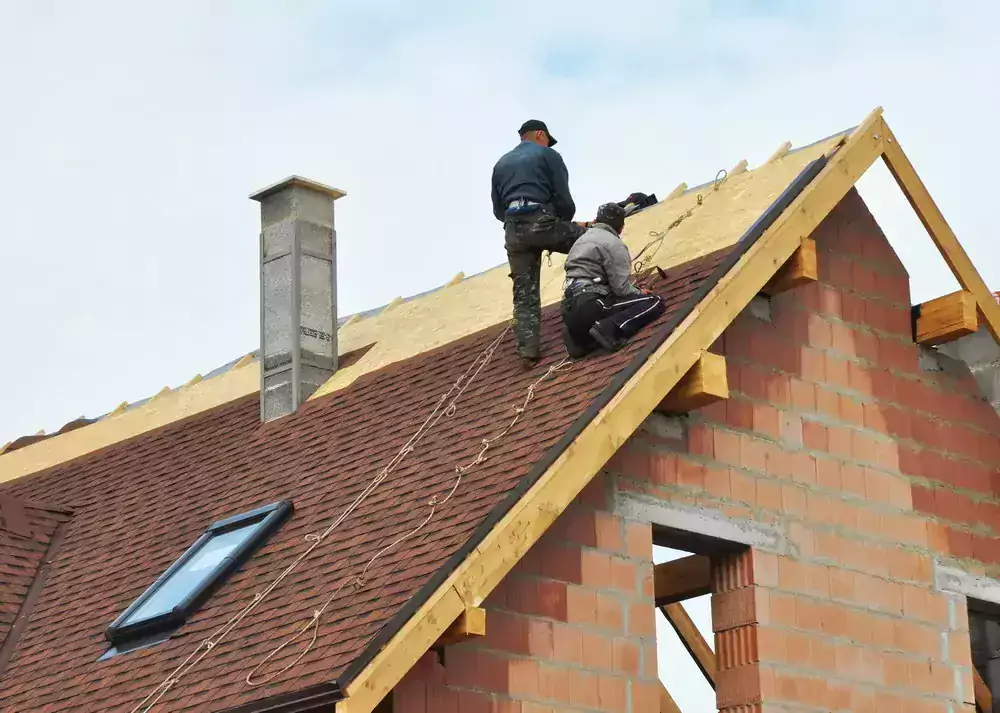
Your roof is your home’s first line of defense against wind, rain, hail, and heat. It’s regularly exposed to weather hazards and other harsh elements...

When it comes to protecting your home from the elements, a strong and resilient roof is essential. One innovative roofing system that has gained...

As with most everything to do with home ownership, roofs will eventually need to be repaired, or replaced.